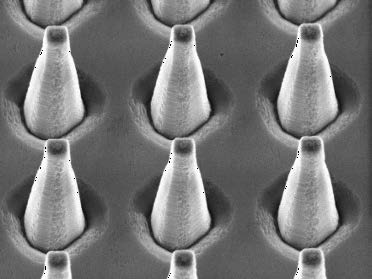

Quantum sensors are able to measure values such as magnetic or electric fields, pressure and temperature at smallest level. The detection of these parameters can be performed on molecules and atoms, and furthermore, be conducted on nanoelectronic structures. This allows for the development of novel technologies for electronic, communication, data processing and biomedicine applications. A European research consortium has set its aim to get these new applications off the ground by significantly increasing the sensitivity of quantum sensors. Fraunhofer Institute for Applied Solid State Physics IAF produces key materials for this endeavor, such as nitrogen-doped diamond as a basis for quantum technological components.
In the project »AsteriQs«, 22 project partners from eight EU countries have joined forces to develop efficient quantum sensors. This technology will find various applications, for example in current sensors for the characterization of neuronal networks, battery charge and discharge processes and magnetic field based navigation systems. Through these innovations neurological disorders could be diagnosed faster in the future, long-lasting batteries would promote electro mobility and a magnetomery-based navigational system, which works independently from GPS, would increase the safety of autonomous driving. The three-year project has started in 2018 and is founded with almost 10 million euros as a part of the overall initiative »quantum flagship«, which is supported by the European Commission. The French Thales Group is in charge of its coordination.
Observing, Understanding and Controlling Quantum Mechanics
Quantum mechanics promises to understand matter on the level of a single quantum object, such as an electron, atom or molecule. Despite having been known for a century, quantum effects still hold many mysteries. Especially the use of single electron and nuclear spins as well as their entanglement will be the focus of upcoming quantum technological developments. »The exact measurement of smallest spin effects in atoms and molecules builds the foundation for the second generation of quantum technology. This will allow the use of quantum effects for the development of nanoscopic sensors with a sensitivity increased by orders of magnitude«, explains Dr. Christoph Nebel from Fraunhofer IAF. AsteriQs paves the way for this technology, i.a. in the field of data processing, communication, sensor systems and biomedicine that in regard of its safety, efficiency, pace and precision completely eclipse existing technology.
Magnetometry with Diamond
The acronym AsteriQs stands for »Advanced Science and Technology Through Diamond Quantum Sensing« and puts the material base, on which quantum sensors will be developed, in concrete terms: Ultrapure diamond with nitrogen vacancy centers (NV centers) allows the sensing of smallest magnetic, electric, pressure and temperature fields with a spatial resolution of a few nanometers. In the diamond laboratory at IAF, ultrapure diamond layers are produced, doped with magnetic NV centers and integrated into smallest diamond tips or photonic structures through ingenious technology. The spin effects are being refined inside the diamond by optimized isotopic compositions of the 12C and 13C carbon atoms. In order to couple into and decouple from the light that is required for observations, waveguide structures are introduced by dry etching. These manufactured photonic structures are mounted on silicon or quartz layers through atomic forces (Van-de Waals forces) and integrated into components.
Quantum Flagship Initiative
In order to assure Europe’s top position in research and knowledge transfer of quantum physics into the market, the European Commission started its biggest research program so far in 2018: the quantum flagship. With a budget of one billion euros and a duration of ten years, the initiative supports the cooperation of research institutes, science, industry and political decision makers. Among 140 submitted project proposals 20 projects were been chosen. Fraunhofer IAF is represented with two projects. In both projects (AsteriQs and MetaboliQs) Freiburg’s Fraunhofer institute weighs in its expertise in the field of growth, doping and technology of monocrystalline diamond. The project MetaboliQs is concerned with the hyperpolarization of biomarker molecules for MRI applications (view www.metaboliqs.eu). In this undertaking, Fraunhofer IAF functions as project coordinator and capitalizes on the highly developed method of Fraunhofer-Gesellschaft for the organization and management of complex interdisciplinary projects.
 Fraunhofer Institute for Applied Solid State Physics IAF
Fraunhofer Institute for Applied Solid State Physics IAF